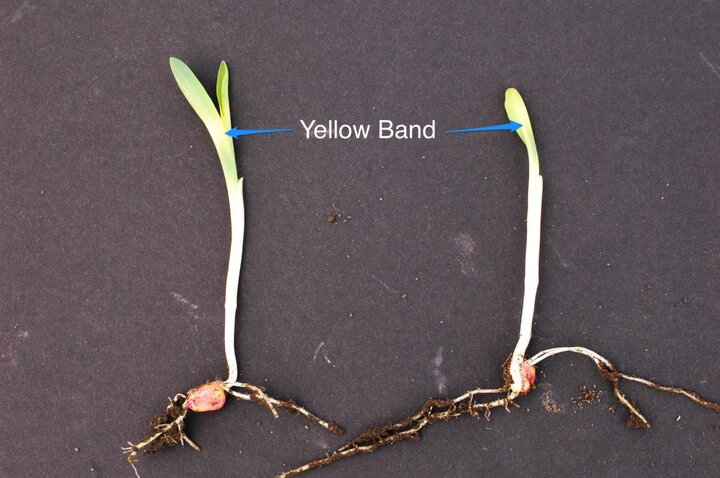2017 Observations in South Central Nebraska
Soil temperatures at South Central Agricultural Laboratory (SCAL) fell from 63⁰ F on April 19 to 43⁰ F on April 30, negatively affecting corn germination rates and emergence uniformity. These soil temperature readings were at the 4-inch depth; temperature dips were likely even greater at two inches ― a typical corn seeding depth. The dramatic soil weather change affected corn germination and emergence at other locations as well. (See below and related May 5 CW article.)
Early-planted corn at SCAL (April 17), was not emerged during the cold snap, but upon emergence displayed symptoms similar to what Greaves (1996) termed “cross-banding” (Figures 1, 2 and 3). These yellow to pale green, horizontal bands ― perpendicular to the leaf midribs ― often appear in a similar position on other seedlings and at about the same height above ground on different leaves of the same plant. Other terms that perhaps are used for this symptom may include frost, color, or cold banding. In this situation, no herbicides had been applied.
Greaves and others reported on emerged plants were affected by the cold spell, which was different from what we were seeing this year at SCAL. In our situation this year, below ground seedlings were affected. The first and second leaves, while still tightly wrapped in the coleoptile, were damaged before emergence. Hybrids clearly differ in cold tolerance (Greaves, 1996) and probably in extent of cold banding in these situations.
Although these symptoms early-on are interesting, the plants shown in these photos should recover well given some sun and warm conditions. However, variation in emergence timing and subsequent growth and development in fields like this will affect yields to a small, hardly measurable extent. However, if remaining stands are reasonable, fields like this would certainly not be cause for replanting.
Reference on “Cross-banding”
Greaves. J.A. 1996. Improving suboptimal temperature tolerance in maize — the search for variation. Journal of Experimental Botany, Vol. 47, No. 296, pp. 307-323.


Scout Early-Planted Corn
Earlier this week Trent Nekoliczak shared this photo of corn planted April 24 near Cedar Rapids. Conditions were good, he reported, as he planted in soil temperatures of about 54°F; however, soil temperatures dropped to 40°F almost 24 hours after planting and stayed that low for almost a week, leading to these cork-screwed seedlings he found when scouting for pre-emergent and newly emerged seedlings.
See how the April coldsnap may have affected early-planted corn in this April 24 CW article as well as how to assess the need for replanting in this May 5 CropWatch article.


